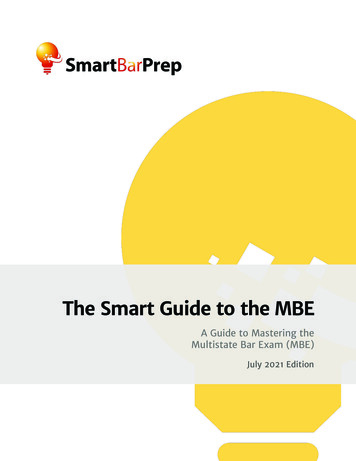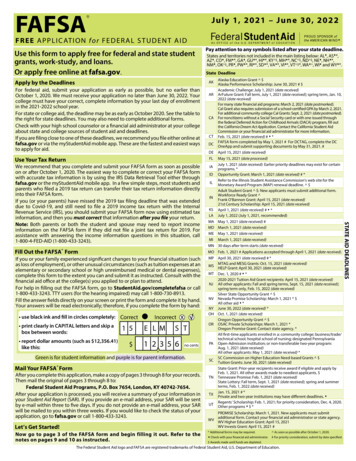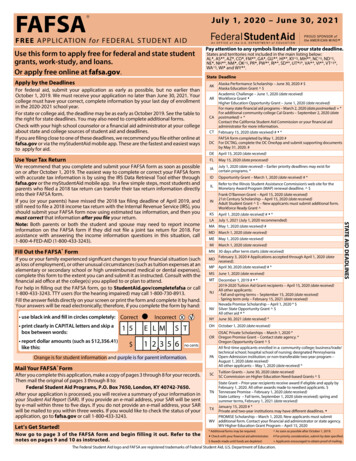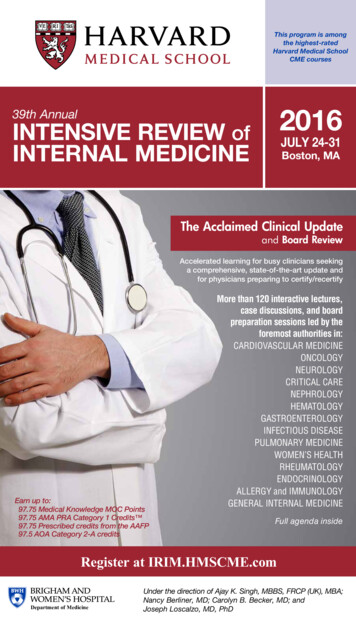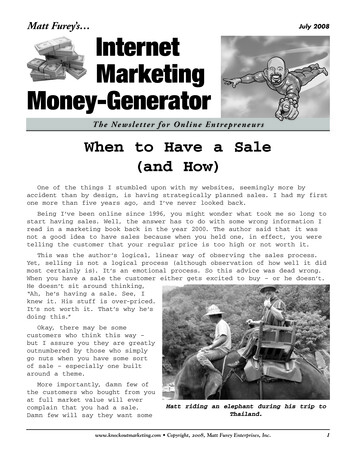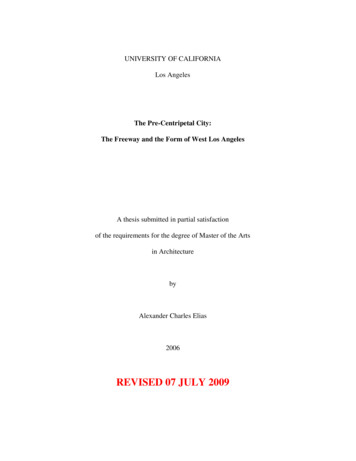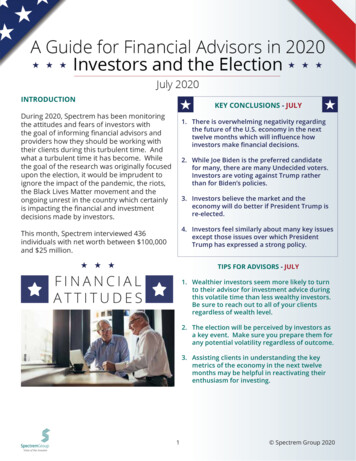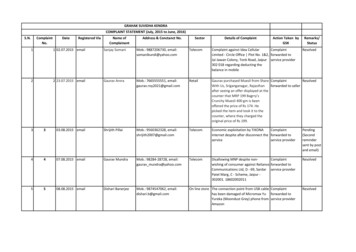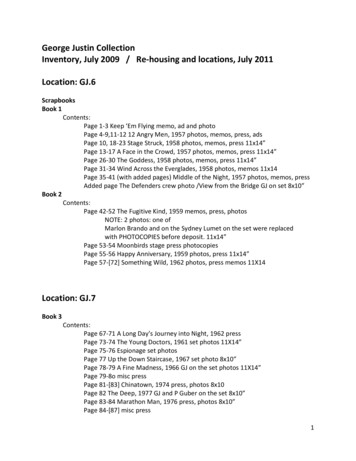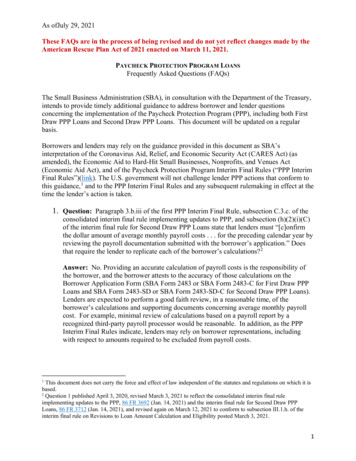
Transcription
As of July 29, 2021These FAQs are in the process of being revised and do not yet reflect changes made by theAmerican Rescue Plan Act of 2021 enacted on March 11, 2021.PAYCHECK PROTECTION PROGRAM LOANSFrequently Asked Questions (FAQs)The Small Business Administration (SBA), in consultation with the Department of the Treasury,intends to provide timely additional guidance to address borrower and lender questionsconcerning the implementation of the Paycheck Protection Program (PPP), including both FirstDraw PPP Loans and Second Draw PPP Loans. This document will be updated on a regularbasis.Borrowers and lenders may rely on the guidance provided in this document as SBA’sinterpretation of the Coronavirus Aid, Relief, and Economic Security Act (CARES Act) (asamended), the Economic Aid to Hard-Hit Small Businesses, Nonprofits, and Venues Act(Economic Aid Act), and of the Paycheck Protection Program Interim Final Rules (“PPP InterimFinal Rules”)(link). The U.S. government will not challenge lender PPP actions that conform tothis guidance, 1 and to the PPP Interim Final Rules and any subsequent rulemaking in effect at thetime the lender’s action is taken.1. Question: Paragraph 3.b.iii of the first PPP Interim Final Rule, subsection C.3.c. of theconsolidated interim final rule implementing updates to PPP, and subsection (h)(2)(i)(C)of the interim final rule for Second Draw PPP Loans state that lenders must “[c]onfirmthe dollar amount of average monthly payroll costs . . . for the preceding calendar year byreviewing the payroll documentation submitted with the borrower’s application.” Doesthat require the lender to replicate each of the borrower’s calculations? 2Answer: No. Providing an accurate calculation of payroll costs is the responsibility ofthe borrower, and the borrower attests to the accuracy of those calculations on theBorrower Application Form (SBA Form 2483 or SBA Form 2483-C for First Draw PPPLoans and SBA Form 2483-SD or SBA Form 2483-SD-C for Second Draw PPP Loans).Lenders are expected to perform a good faith review, in a reasonable time, of theborrower’s calculations and supporting documents concerning average monthly payrollcost. For example, minimal review of calculations based on a payroll report by arecognized third-party payroll processor would be reasonable. In addition, as the PPPInterim Final Rules indicate, lenders may rely on borrower representations, includingwith respect to amounts required to be excluded from payroll costs.1This document does not carry the force and effect of law independent of the statutes and regulations on which it isbased.2Question 1 published April 3, 2020, revised March 3, 2021 to reflect the consolidated interim final ruleimplementing updates to the PPP, 86 FR 3692 (Jan. 14, 2021) and the interim final rule for Second Draw PPPLoans, 86 FR 3712 (Jan. 14, 2021), and revised again on March 12, 2021 to conform to subsection III.1.h. of theinterim final rule on Revisions to Loan Amount Calculation and Eligibility posted March 3, 2021.1
As of July 29, 2021These FAQs are in the process of being revised and do not yet reflect changes made by theAmerican Rescue Plan Act of 2021 enacted on March 11, 2021.If the lender identifies errors in the borrower’s calculation or material lack ofsubstantiation in the borrower’s supporting documents, the lender should work with theborrower to remedy the issue.2. Question: Are small business concerns (as defined in section 3 of the Small BusinessAct, 15 U.S.C. 632) required to have 500 or fewer employees to be eligible borrowers forFirst Draw PPP Loans? 3Answer: No. Small business concerns can be eligible borrowers for First Draw PPPLoans even if they have more than 500 employees, as long as they satisfy the existingstatutory and regulatory definition of a “small business concern” under section 3 of theSmall Business Act, 15 U.S.C. 632. A business can qualify if it meets the SBAemployee-based or revenue-based size standard corresponding to its primary industry.Go to www.sba.gov/size for the industry size standards.Additionally, a business can qualify for a First Draw PPP Loan as a small businessconcern if it met both tests in SBA’s “alternative size standard” as of March 27, 2020: (1)maximum tangible net worth of the business is not more than 15 million; and (2) theaverage net income after Federal income taxes (excluding any carry-over losses) of thebusiness for the two full fiscal years before the date of the application is not more than 5million.A business that qualifies as a small business concern under section 3 of the SmallBusiness Act, 15 U.S.C. 632, may truthfully attest to its eligibility for a First Draw PPPLoan on the Borrower Application Form, unless otherwise ineligible.Notwithstanding the foregoing, housing cooperatives, eligible 501(c)(6) organizations,and eligible destination marketing organizations, are eligible for a First Draw PPP Loanonly if they employ no more than 300 employees. 43. Question: Does my business have to qualify as a small business concern (as defined insection 3 of the Small Business Act, 15 U.S.C. 632) in order to receive a First Draw PPPLoan? 5Question 2 published April 6, 2020 and revised March 3, 2021 to reflect the consolidated interim final ruleimplementing updates to the PPP. This FAQ applies only to First Draw PPP Loans. Different eligibilityrequirements apply to Second Draw PPP Loans. See FAQ #63 and subsection (c) of the interim final rule forSecond Draw PPP Loans.4See subsections B.1.g.v., B.1.g.vii., and B.1.g.viii. of the consolidated interim final rule implementing updates tothe PPP for additional information on the eligibility of housing cooperatives, destination marketing organizations,and section 501(c)(6) organizations.5Question 3 published April 6, 2020 and revised March 3, 2021 to reflect the consolidated interim final ruleimplementing updates to the PPP. This FAQ applies only to First Draw PPP Loans. Different eligibilityrequirements apply to Second Draw PPP Loans. See FAQ #63 and subsection (c) of the interim final rule forSecond Draw PPP Loans.32
As of July 29, 2021These FAQs are in the process of being revised and do not yet reflect changes made by theAmerican Rescue Plan Act of 2021 enacted on March 11, 2021.Answer: No. In addition to small business concerns, a business is eligible for a FirstDraw PPP Loan if the business has 500 or fewer employees or the business meets theSBA employee-based or revenue-based size standard for the industry in which it operates(if applicable). Similarly, First Draw PPP Loans are also available for qualifying taxexempt nonprofit organizations described in section 501(c)(3) of the Internal RevenueCode (IRC), tax-exempt veterans organization described in section 501(c)(19) of the IRC,Tribal business concerns described in section 31(b)(2)(C) of the Small Business Act, andeligible nonprofit news organizations 6 that have 500 or fewer employees or meet theSBA employee-based size standards for the industry in which they operate. First DrawPPP Loans also are available for housing cooperatives, eligible section 501(c)(6)organizations, and eligible destination marketing organizations that employ not more than300 employees.4. Question: Are lenders required to make an independent determination regardingapplicability of affiliation rules under 13 C.F.R. 121.301(f) to borrowers? 7Answer: No. It is the responsibility of the borrower to determine which entities (if any)are its affiliates and determine the employee headcount of the borrower and its affiliates.Lenders are permitted to rely on borrowers’ certifications.5. Question: Are borrowers required to apply SBA’s affiliation rules under 13 C.F.R.121.301(f)? 8Answer: Yes. Borrowers must apply the affiliation rules, including any applicableexceptions or affiliation waivers, set forth in SBA’s Interim Final Rule on Affiliation,Interim Final Rule on Treatment of Entities with Foreign Affiliates, the consolidatedinterim final rule implementing updates to the PPP, and the interim final rule for SecondDraw PPP Loans. A borrower must certify on the applicable Borrower Application Formthat the borrower is eligible to receive a PPP loan. For a First Draw PPP Loan, thatcertification means that the borrower has no more than 500 employees, is a smallbusiness concern as defined in section 3 of the Small Business Act (15 U.S.C. 632) thatmeets the applicable SBA employee-based or revenue-based size standard, or meets thetests in SBA’s alternative size standard, after applying the affiliation rules, if applicable.(Notwithstanding the foregoing, housing cooperatives, eligible 501(c)(6) organizations,and eligible destination marketing organizations, are eligible for a First Draw PPP Loanonly if they employ no more than 300 employees.) For a Second Draw PPP Loan, thatcertification means the borrower has no more than 300 employees, after applying theSee subsection B.1.g.vi. of the consolidated interim final rule implementing updates to the PPP and FAQ #56 foradditional information on the eligibility of nonprofit news organizations.7Question 4 published April 6, 2020.8Question 5 published April 6, 2020 and revised March 3, 2021 to conform to subsections B.1.g.v., B.1.g.vii., andB.1.g.viii of the consolidated interim final rule implementing updates to the PPP and subsection (c) of the interimfinal rule on Second Draw PPP Loans.63
As of July 29, 2021These FAQs are in the process of being revised and do not yet reflect changes made by theAmerican Rescue Plan Act of 2021 enacted on March 11, 2021.affiliation rules, if applicable, and the borrower meets the other eligibility requirements insubsection (c) of the interim final rule for Second Draw PPP Loans. SBA’s existingaffiliation exclusions apply to the PPP, including, for example the exclusions under 13CFR 121.103(b)(2).6. Question: The affiliation rule based on ownership (13 C.F.R. 121.301(f)(1)) states thatSBA will deem a minority shareholder in a business to control the business if theshareholder has the right to prevent a quorum or otherwise block action by the board ofdirectors or shareholders. If a minority shareholder irrevocably gives up those rights, is itstill considered to be an affiliate of the business? 9Answer: No. If a minority shareholder in a business irrevocably waives or relinquishesany existing rights specified in 13 C.F.R. 121.301(f)(1), the minority shareholder wouldno longer be an affiliate of the business (assuming no other relationship that triggers theaffiliation rules).7. Question: Section 7(a)(36)(A)(viii)(II) of the Small Business Act excludes from thedefinition of payroll costs any employee compensation in excess of 100,000 on anannualized basis, as prorated for the period during which the payments are made or theobligation to make the payments is incurred. Does that exclusion apply to all employeebenefits of monetary value? 10Answer: No. The exclusion of compensation in excess of 100,000 on an annualizedbasis, as prorated for the period during which the payments are made or the obligation tomake the payments is incurred, applies only to cash compensation, not to non-cashbenefits, including: employer contributions to defined-benefit or defined-contribution retirementplans; payment for the provision of employee benefits consisting of group health care orgroup life, disability, vision, or dental insurance coverage, including insurancepremiums; and payment of state and local taxes assessed on compensation of employees.8. Question: Do PPP loans cover paid sick leave? 11Answer: Yes. PPP loans cover payroll costs, including costs for employee vacation,parental, family, medical, and sick leave. However, the CARES Act excludes qualifiedsick and family leave wages for which a credit is allowed under sections 7001 and 7003Question 6 published April 6, 2020.Question 7 published April 6, 2020 and revised March 3, 2021 to conform to subsection B.4.h.ii. of theconsolidated interim final rule implementing updates to the PPP.11Question 8 published April 6, 2020.9104
As of July 29, 2021These FAQs are in the process of being revised and do not yet reflect changes made by theAmerican Rescue Plan Act of 2021 enacted on March 11, 2021.of the Families First Coronavirus Response Act (Public Law 116–127). Learn moreabout the Paid Sick Leave Refundable Credit here.9. Question: My small business is a seasonal business whose activity increases from Aprilto June. Considering activity from that period would be a more accurate reflection of mybusiness’s operations. However, my small business was not fully ramped up on February15, 2020. Am I still eligible? 12Answer: In evaluating a borrower’s eligibility, a lender may consider a seasonalborrower to have been in operation on February 15, 2020 if the business was in operationfor any 12-week period between February 15, 2019 and February 15, 2020.10. Question: What if an eligible borrower contracts with a third-party payer such as apayroll provider or a Professional Employer Organization (PEO) to process payroll andreport payroll taxes? 13Answer: SBA recognizes that eligible borrowers that use PEOs or similar payrollproviders are required under some state registration laws to report wage and other data onthe Employer Identification Number (EIN) of the PEO or other payroll provider. In thesecases, payroll documentation provided by the payroll provider that indicates the amountof wages and payroll taxes reported to the IRS by the payroll provider for the borrower’semployees will be considered acceptable PPP loan payroll documentation. Relevantinformation from a Schedule R (Form 941), Allocation Schedule for Aggregate Form 941Filers, attached to the PEO’s or other payroll provider’s Form 941, Employer’s QuarterlyFederal Tax Return, should be used if it is available; otherwise, the eligible borrowershould obtain a statement from the payroll provider documenting the amount of wagesand payroll taxes. In addition, employees of the eligible borrower will not be consideredemployees of the eligible borrower’s payroll provider or PEO.11. Question: May lenders accept signatures from a single individual who is authorized tosign on behalf of the borrower? 14Answer: Yes. However, the borrower should bear in mind that, as the BorrowerApplication Forms indicate, only an authorized representative of the applicant seeking aloan may sign on behalf of the applicant. An individual’s signature as an “AuthorizedRepresentative of Applicant” is a representation to the lender and to the U.S. governmentthat the signer is authorized to make the certifications, including with respect to theapplicant and each owner of 20% or more of the applicant’s equity, contained in theQuestion 9 published April 6, 2020 and revised March 3, 2021 to conform to subsection B.1.e. of the consolidatedinterim final rule implementing updates to the PPP.13Question 10 published April 6, 2020.14Question 11 published April 6, 2020 and revised March 3, 2021 to clarify applicability to non-profits.125
As of July 29, 2021These FAQs are in the process of being revised and do not yet reflect changes made by theAmerican Rescue Plan Act of 2021 enacted on March 11, 2021.Borrower Application Form. Lenders may rely on that representation and accept a singleindividual’s signature on that basis.12. Question: I need to request a loan to support my small business operations in light ofcurrent economic uncertainty. However, I pleaded guilty to a felony crime a very longtime ago. Am I still eligible for the PPP? 15Answer: A business is ineligible due to an owner’s criminal history only if an owner of20 percent or more of the equity of the applicant: is presently incarcerated or, for any felony, is presently subject to an indictment,criminal information, arraignment, or other means by which formal criminalcharges are brought in any jurisdiction; or has been convicted of, pleaded guilty or nolo contendere to, or commenced anyform of parole or probation (including probation before judgment) for, a felonyinvolving fraud, bribery, embezzlement, or a false statement in a loan applicationor an application for federal financial assistance within the last five years.13. Question: Are lenders permitted to use their own online portals and an electronic formthat they create to collect the same information and certifications as in the BorrowerApplication Forms, in order to complete implementation of their online portals? 16Answer: Yes. Lenders may use their own online systems and a form they establish thatasks for the same information (using the same language) as the Borrower ApplicationForms. Lenders are still required to send the data to SBA using SBA’s interface.14. Question: What time period should borrowers use to determine their number ofemployees? 17Answer: Borrowers may use their average employment over the time period used tocalculate their loan amount to determine their number of employees, for the purposes ofapplying an employee-based size standard. Alternatively, borrowers may elect to useSBA’s usual calculation: the average number of employees per pay period in the 12Question 12 published April 6, 2020, revised June 25, 2020, and revised again on March 12, 2021 to conform tosubsection B.2.a.iii. of the consolidated interim final rule implementing updates to the PPP (86 FR 3692, 3698), asamended by subsection III.2 of the interim final rule on Revisions to Loan Amount Calculation and Eligibilityposted March 3, 2021.16Question 13 published April 6, 2020 and revised March 3, 2021 to include multiple Borrower Application Forms.17Question 14 published April 6, 2020 and revised March 3, 2021 to conform to the consolidated interim final ruleimplementing updates to the PPP and the interim final rule for Second Draw PPP Loans and to make other changes.First, Question 14 has been revised to remove discussion of how to calculate a borrower’s maximum loan amountbecause that question has been addressed in greater detail in the documents “How to Calculate Maximum LoanAmounts for First Draw PPP Loans and What Documentation to Provide – by Business Type” (link) and “SecondDraw Paycheck Protection Program (PPP) Loans: How to Calculate Revenue Reduction and Maximum LoanAmounts Including What Documentation to Provide” (link). Second, Question 14 has been revised to clarify howseasonal employers determine their number of employees.156
As of July 29, 2021These FAQs are in the process of being revised and do not yet reflect changes made by theAmerican Rescue Plan Act of 2021 enacted on March 11, 2021.completed calendar months prior to the date of the loan application (or the averagenumber of employees for each of the pay periods that the business has been operational,if it has not been operational for 12 months).Seasonal businesses must use the average number of employees per pay period during the12-calendar week period the borrower used to calculate its payroll costs.15. Question: Should payments that an eligible borrower made to an independent contractoror sole proprietor be included in calculations of the eligible borrower’s payroll costs? 18Answer: No. Any amounts that an eligible borrower has paid to an independentcontractor or sole proprietor should be excluded from the eligible business’s payrollcosts, except for fishing boat owners as permitted by PPP interim final rules. 19 However,an independent contractor or sole proprietor will itself be eligible for a loan under thePPP, if it satisfies the applicable requirements.16. Question: How should a borrower account for federal taxes when determining itspayroll costs for purposes of the maximum loan amount, allowable uses of a PPP loan,and the amount of a loan that may be forgiven? 20Answer: Payroll costs are calculated on a gross basis without regard to (i.e., notincluding subtractions or additions based on) federal taxes imposed or withheld, such asthe employee’s and employer’s share of Federal Insurance Contributions Act (FICA) andincome taxes required to be withheld from employees. As a result, payroll costs are notreduced by taxes imposed on an employee and required to be withheld by the employer,but payroll costs do not include the employer’s share of payroll tax. For example, anemployee who earned 4,000 per month in gross wages, from which 500 in federal taxeswas withheld, would count as 4,000 in payroll costs. The employee would receive 3,500, and 500 would be paid to the federal government. However, the employer-sidefederal payroll taxes imposed on the 4,000 in wages are excluded from payroll costsunder the statute. 21Question 15 published April 6, 2020 and revised March 3, 2021 to incorporate the exception for fishing boatowners.19See 85 FR 39066, subsection III.1. (June 30, 2020) and subsection B.4.i. of the consolidated interim final ruleimplementing updates to the PPP.20Question 16 published April 6, 2020 and revised March 3, 2021 to conform to the consolidated interim final ruleimplementing updates to the PPP.21The definition of “payroll costs” in the CARES Act, 15 U.S.C. 636(a)(36)(A)(viii), excludes “taxes imposed orwithheld under chapters 21, 22, or 24 of the Internal Revenue Code of 1986 during the covered period,” defined asFebruary 15, 2020, to June 30, 2020. As described above, the SBA interprets this statutory exclusion to mean thatpayroll costs are calculated on a gross basis, without subtracting federal taxes that are imposed on the employee orwithheld from employee wages. Unlike employer-side payroll taxes, such employee-side taxes are ordinarilyexpressed as a reduction in employee take-home pay; their exclusion from the definition of payroll costs meanspayroll costs should not be reduced based on taxes imposed on the employee or withheld from employee wages.187
As of July 29, 2021These FAQs are in the process of being revised and do not yet reflect changes made by theAmerican Rescue Plan Act of 2021 enacted on March 11, 2021.17. Question: I filed or approved a loan application based on the version of the PPP InterimFinal Rules published at the time of the application. Do I need to take any action basedon the updated guidance in these FAQs? 22Answer: No. Borrowers and lenders may rely on the laws, rules, and guidance availableat the time of the relevant application. However, borrowers whose previously submittedloan applications have not yet been processed may revise their applications based onclarifications reflected in these FAQs.18. Question: Are PPP loans for existing customers considered new accounts for FinCENRule CDD purposes? Are lenders required to collect, certify, or verify beneficialownership information in accordance with the rule requirements for existing customers? 23Answer: If the PPP loan is being made to an existing customer and the necessaryinformation was previously verified, you do not need to re-verify the information.Furthermore, if federally insured depository institutions and federally insured creditunions eligible to participate in the PPP program have not yet collected beneficialownership information on existing customers, such institutions do not need to collect andverify beneficial ownership information for those customers applying for new PPP loans,unless otherwise indicated by the lender’s risk-based approach to BSA compliance.19. Question: Do lenders have to use a promissory note provided by SBA or may they usetheir own? 24Answer: Lenders may use their own promissory note or an SBA form of promissorynote.20. Question: The amount of forgiveness of a PPP loan depends on the borrower’s payrollcosts over the applicable forgiveness covered period. When does the applicableforgiveness covered period begin? 25This interpretation is consistent with the text of the statute and advances the legislative purpose of ensuring workersremain paid and employed. Further, because the reference period for determining a borrower’s maximum loanamount will entirely precede the period during which borrowers will be subject to the restrictions on allowable usesof the loans, for purposes of the determination of allowable uses of loans and the amount of loan forgiveness, thisstatutory exclusion will apply with respect to such taxes imposed or withheld at any time, not only during suchperiod.22Question 17 published April 6, 2020 and revised March 3, 2021 to reflect subsequent rulemaking.23Question 18 published April 6, 2020. See FAQs #54 and #55 regarding application of these requirements toSecond Draw PPP Loans.24Question 19 published April 8, 2020.25Question 20 published April 8, 2020 and revised June 25, 2020. This question was further revised on March 3,2021 to reflect the consolidated interim final rule implementing updates to the PPP.8
As of July 29, 2021These FAQs are in the process of being revised and do not yet reflect changes made by theAmerican Rescue Plan Act of 2021 enacted on March 11, 2021.Answer: The CARES Act provided for an eight-week forgiveness covered period thatstarts on the date the lender makes a disbursement of the PPP loan to the borrower. Thelender must disburse the loan no later than 10 calendar days from the date of loanapproval.The Paycheck Protection Program Flexibility Act of 2020, which became law on June 5,2020, extended the covered period for loan forgiveness from eight weeks after the date ofloan disbursement to 24 weeks after the date of loan disbursement, providingsubstantially greater flexibility for borrowers to qualify for loan forgiveness. The 24week period applies to all borrowers that received forgiveness prior to December 27,2020, but borrowers that received an SBA loan number before June 5, 2020, have theoption to use an eight-week period.The Economic Aid to Hard-Hit Small Businesses, Nonprofits, and Venues Act(Economic Aid Act), enacted on December 27, 2020, changed the definition of “loanforgiveness covered period” to the period beginning on the date the lender disburses thePPP loan and ending on any date selected by the borrower that occurs during the period(i) beginning on the date that is 8 weeks after the date of disbursement and (ii) ending onthe date that is 24 weeks after the date of disbursement.21. Question: Do lenders need a separate SBA Authorization document to issue PPPloans? 26Answer: No. A lender does not need a separate SBA Authorization for SBA toguarantee a PPP loan. However, lenders must have executed SBA Form 2484 (Lender’sApplication - Paycheck Protection Program Loan Guaranty) or SBA Form 2484-SD(Lender’s Application - Second Draw Loan Guaranty) 27 to issue PPP loans and receive aloan number for each originated PPP loan. Lenders may include in their promissorynotes for PPP loans any terms and conditions, including relating to amortization anddisclosure, that are not inconsistent with the CARES Act, the Economic Aid Act, the PPPInterim Final Rules and guidance, and SBA Form 2484 or SBA Form 2484-SD.22. Question: I am a non-bank lender that meets all applicable criteria of the PPP InterimFinal Rules. Will I be automatically enrolled as a PPP lender? What criteria will SBAand the Treasury Department use to assess whether to approve my application toparticipate as a PPP lender? 28Question 21 published April 13, 2020 and revised March 3, 2021 to conform to the interim final rule for SecondDraw PPP Loans.27This requirement is satisfied by a lender when the lender completes the process of submitting a loan throughSBA’s electronic loan processing system; no transmission or retention of a physical copy of SBA Form 2484 orSBA 2484-SD is required.28Question 22 published April 13, 2020 and revised March 3, 2021 to reflect the consolidated interim final ruleimplementing updates to the PPP.269
As of July 29, 2021These FAQs are in the process of being revised and do not yet reflect changes made by theAmerican Rescue Plan Act of 2021 enacted on March 11, 2021.Answer: We encourage lenders that are not currently 7(a) lenders to apply in order toincrease the scope of PPP lending options and the speed with which PPP loans can bedisbursed to help small businesses across America. We recognize that financialtechnology solutions can promote efficiency and financial inclusion in implementing thePPP. Applicants should submit SBA Form 3507 and the relevant attachments toNFRLApplicationForPPP@sba.gov. Submission of the SBA Form 3507 does not resultin automatic enrollment in the PPP. SBA and the Treasury Department will evaluateeach application from a non-bank or non-insured depository institution lender anddetermine whether the applicant has the necessary qualifications to process, close,disburse, and service PPP loans made with SBA’s guarantee. SBA may requestadditional information from the applicant before making a determination.23. Question: How do the 10 million cap (or 2 million cap for a Second Draw PPP Loan)and affiliation rules work for franchises? 29Answer: If a franchise brand is listed on the SBA Franchise Directory, each of itsfranchisees that meets the applicable size standard can apply for a PPP loan. (Thefranchisor does not apply on behalf of its franchisees.) The 10 million cap on FirstDraw PPP Loans (or 2 million cap for a Second Draw PPP Loan) is a limit perfranchisee entity, and each franchisee is limited to one First Draw and one Second DrawPPP Loan.Franchise brands that have been denied listing on the Directory because of affiliationbetween franchisor and franchisee may request listing to receive PPP loans. SBA willnot apply affiliation rules to a franchise brand requesting listing on the Directory toparticipate in the PPP, but SBA will confirm that the brand is otherwise eligible forlisting on the Directory.24. Question: How do the 10 million cap (or 2 million cap for a Second Draw PPP Loan)and affiliation rules work for hotels and restaurants (and any business assigned a NorthAmerican Industry Classification System (NAICS) code beginning with 72)? 30Answer: Any single business entity that is assigned a NAICS code beginning with 72(i
Question 1 published April 3, 2020, revised March 3, 2021 to reflect the consolidated interim final rule implementing updates to the PPP, 86 FR 3692 (Jan. 14, 2021) and the interim final rule for Second Draw PPP Loans, 86 FR 3712 (Jan. 14, 2021), and revised again o
